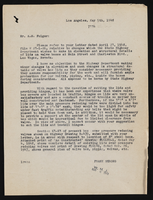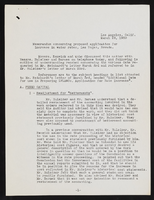Search the Special Collections and Archives Portal
Search Results
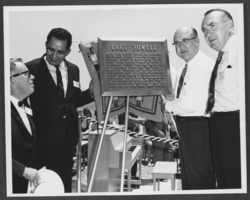
Photograph of Powell Commemorative Ceremony, Lake Powell, June 19, 1969
Date
1969-06-19
Archival Collection
Description
The unveiling of a plaque dedicated to the memory of Major John Wesley Powell at a Powell Commemorative Ceremony on Lake Powell. From left to right, the individuals identified are Governor Jack Williams of Arizona; Chairman Raymond Nakai of the Navajo Tribal Council; James R. Smith, Assistant Secretary of the Interior; and Governor Calvin L. Rampton of Utah. The plaque reads as follows: "Lake Powell; Major John Wesley Powell led scientific exploration parties down the Green and Colorado Rivers in 1869 and in 1871-72. Years later Powell became a leader in government science programs, headed the U. S. Geological Survey and the Bureau of American Ethnology, and advocated enlightened land and water conservation policies which resulted in the passage of the Reclamation Act of 1902. In commemoration of his courage, his wisdom, and his years of public service, the reservoir behind Glen Canyon Dam as been named Lake Powell."
Image
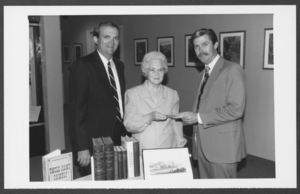
Photograph of UNLV reception honoring Elbert and Mary Edwards, Las Vegas, July 24, 1991
Date
1991-07-24
Archival Collection
Description
Description provided with image: "L-R: Jim Gammett, outgoing President of the Las Vegas Rotary Club; Mary Edwards; Rob Moore, incoming president of the Rotary Club. Occasion is the presentation of a $3,000 check from the club to the Elbert Edwards Scholarship Fund at Boulder City High School. The presentation was made at a reception held at UNLV Library Special Collections Department honoring Elbert and Mary Edwards and the deposit of Edwards' manuscripts, books, and photographs in the Special Collections Dept. archives. July 24, 1991."
Image
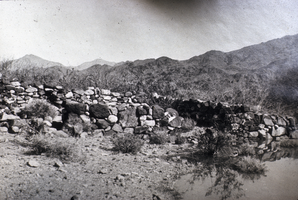
Slide of the Callville ruins, Callville, Nevada, circa 1930s
Date
1930 to 1939
Archival Collection
Description
A view of the Callville ruins at Lake Mead, Nevada. Callville is a former settlement of Clark County, Nevada. Abandoned in 1869, Callville was submerged under 400 feet (120 m) of water after the Colorado River was dammed to form Lake Mead. Callville Bay recreation area is located at the site. Located 350 miles (560 km) from Salt Lake City, Calville was situated on the west bank of the Colorado River, in what was at the time Pah-Ute County, Arizona Territory. The main road to the settlement was along the Virgin River close to St. Thomas, Nevada before heading over hills to the west. A road connected Callville with the main highway at Las Vegas. Callville was established in December 2, 1864 by Anson Call, Dr. James M. Whitmore, A. M. Cannon, Jacob Hamblin and son. It was at the time the southernmost outpost of Mormon settlement. Callville was one of seven Mormon settlements on or near the Muddy River, the others being St. Thomas, Saint Joseph, Overton, West Point, Mill Point later Simonsville and Rioville on the Colorado River above its confluence with the Virgin River. Callville became the county seat of Pah-Ute County, Arizona Territory, in December 1865, before the seat was moved on October 1, 1867 to St. Thomas.
Image
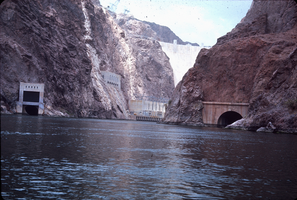
Slide of Hoover Dam taken on the downstream side, circa 1970s
Date
1970 to 1979
Archival Collection
Description
The face of Hoover Dam as seen from the river. Part of the power plant's hydroelectric generators, as well as the canyon wall outlets and stoney gate are visible on the Nevada (left) side. The spillway tunnel is visible on the Arizona (right) side. During the years of lobbying leading up to the passage of legislation authorizing the dam in 1928, Hoover Dam was originally referred to "Boulder Dam" or as "Boulder Canyon Dam", even though the proposed site had shifted to Black Canyon. The Boulder Canyon Project Act of 1928 (BCPA) never mentions a proposed name or title for the dam. When Secretary Wilbur spoke at the ceremony starting the building of the railway between Las Vegas and the dam site on September 17, 1930, he named the dam "Hoover Dam", citing a tradition of naming dams after Presidents, though none had been so honored during their terms of office. After Hoover's election defeat in 1932 and the accession of the Roosevelt administration, Secretary Ickes ordered on May 13, 1933 that the dam be referred to as "Boulder Dam". In the following years, the name "Boulder Dam" failed to fully take hold, with many Americans using both names interchangeably and map makers divided as to which name should be printed. In 1947, a bill passed both Houses of Congress unanimously restoring the name to "Hoover Dam".
Image
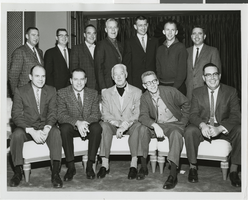
Photograph of Bonanza Airline Officers and Station Managers, Las Vegas, November 27, 1962
Date
1962-11-27
Archival Collection
Description
Bonanza Airline Officers and Station Managers in Las Vegas, Nevada. From left to right, the seated men in the first row include: Frank Chabot (Treasurer), Noland Ryan (Assistant to President), General Joe Battley (Sands Executive), G. Robert Henry (Executive Vice President), and Thomas Magners (Regional Manager of Stations). From left to right, the men standing in the back row include: Glenn Woods (Reno), Blaine Barney (Cedar City), Ed Wolfe (Las Vegas), Larry Ecklund (Blyth), Henry Puryear (Yuma), Ray Vaughn (Santa Ana), and Robert Yeager (El Centro).
Image

Panoramic photograph of Goldfield, Nevada, circa 1905-1908
Date
1905 to 1908
Archival Collection
Description
Panoramic photograph of Goldfield, Nevada with some mines, businesses and significant sites identified. Caption: "The City of Goldfield and some of the mines which have made it famous." "Compliments of the Goldfield Ledge Mining, Co., Exchange Building, Denver, Colorado." Identified: Kendall [Mine]; Columbia Mountain; Sandstorm [Mine]; Electric Transformer Station; Black Butte in Diamondfield; January Mine; Combination Mine; Jumbo Town; Jumbo Mine; St. Ives [Mine]; Florence Mine; Blue Bull Mine; Simmerone Mine; Moose [Goldfield Mining Co.]; Piute; Goldfield Ledge Company's Mines; Schwab-McKane; Dixie [Mine]; Windsor [Mining Co.]; The American Milling & Reduction Co.; Grand St. & Park; Steam Laundry; Catholic Church; Miners' Union Hall; Nixon Bank Building; Fesler Block; Monte Carlo [Saloon]; Main Street; Casson & Ish Mercantile; Hotel Site; Post Office; Columbia St.; Atlanta [Mine]; New Western Reduction Co.; Electric Light Plant; Goldfield Brewing Co.
Image
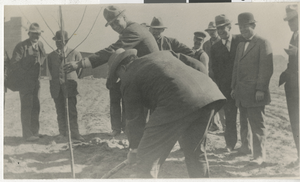
Photograph of people planting first tree in the courthouse park, Las Vegas in March 1911
Date
1911-03
Archival Collection
Description
Black and white photo taken by C. P. Squires on the occasion of planting the first tree in the courthouse park, Las Vegas, Nevada. Date, March 1911, as near as can be fixed. The building shown at left is the first Clark County Court House (now used for Las Vegas City Library) which had been constructed by popular subscription by Las Vegas Business men as promised by them during the county division campaign in 1908-1909. This building provided sufficient quarters for the county offices for five years, following which, the present court house was built. Persons shown, so far as their identity can be remembered are: holding the tree- Ed W. Clark and using the shovel is Judge E. J. L Taber. Others, left to right: Charlie Ronnow, Judge W. R. Thomas, unidentified, unidentified, Bob Dillon, Frank A. Stevens, Harley A. Harmon, and Dr. Roy W. Martin.
Image
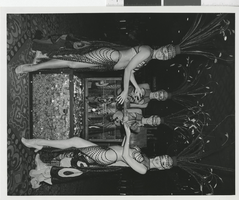
Photograph of four Minsky showgirls dropping coins into a trunk at the Aladdin Hotel, Las Vegas (Nev.), 1972
Date
1972
Archival Collection
Description
Four Minsky's showgirls in beaded costumes and feathered headdress drop handfuls of coins into a chest for an Aladdin promotion. The Aladdin opened on April 1, 1966 and closed on November 25, 1997, and was imploded on 7:30pm, on April 27, 1998, except for the Aladdin Theatre to make way for the construction of an entirely new casino. The new Aladdin was scheduled to reopen on August 17, 2000, at 6:00 p.m. The opening was delayed while the Clark County building inspector completed its fire safety testing. Another delay was caused by last-minute repairs to the casino surveillance system. The new Aladdin finally opened the next day at 7:45 a.m. The casino was sold in bankruptcy on June 20, 2003 to a partnership of Planet Hollywood and Starwood Hotels & Resorts Worldwide. Renovations were carried out in stages, allowing the resort to remain open throughout. The retail space formerly known as "The Desert Passage" was converted into the Hollywood-themed "Miracle Mile Shops" and the theatre formerly known as the "Aladdin Theatre" was converted into "The AXIS". After the casino was renovated, it was reopened as "Planet Hollywood Resort & Casino" on April 17, 2007. Site Name: Aladdin Hotel (Las Vegas, Nev.) Street Address: 3667 South Las Vegas Boulevard
Image
Pagination
Refine my results
Content Type
Creator or Contributor
Subject
Archival Collection
Digital Project
Resource Type
Year
Material Type
Place
Language
Records Classification

